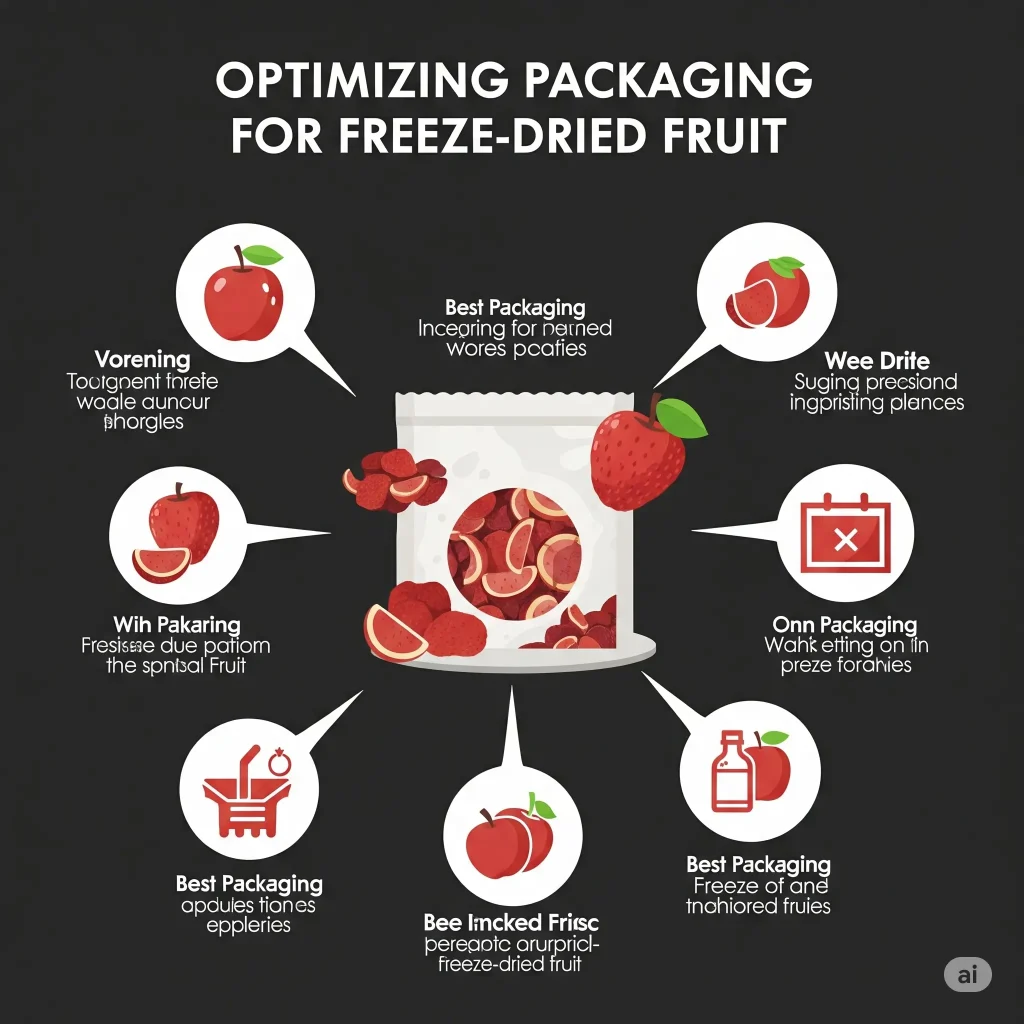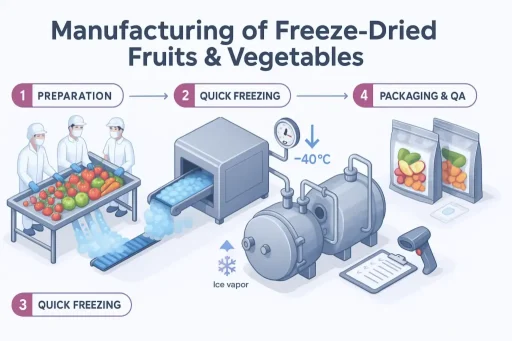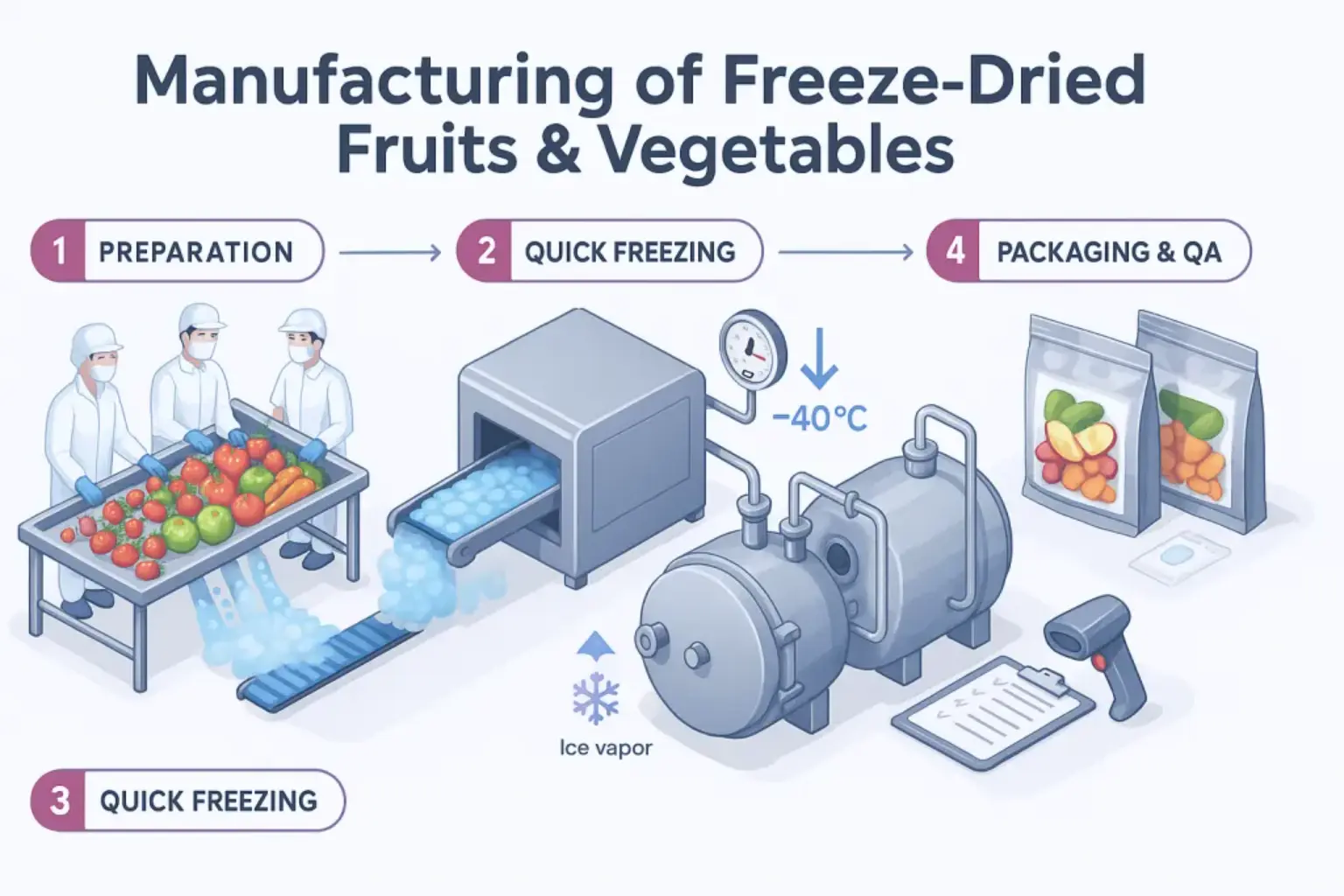If you’re an entrepreneur or part of a startup team considering the food manufacturing space, freeze-dried fruit is one of the most interesting categories to consider. Freeze-dried fruit sits at the intersection of health, convenience, and shelf stability, which is not something you’ll find too often occurring together in food.
Freeze-dried berries, mango, banana, pineapple, apple, and niche superfruits are more than just trail food; they get used as an ingredient in breakfast cereals and granola, toppings in bakery and dairy, bases for smoothies and nutraceutical blends, and clean-label inclusions for ready-to-eat finished products. There are also multiple revenue paths at the end: consumer snacks (D2C/retail), B2B ingredients, private label, and export.
From a manufacturing perspective, freeze-dried fruit is made by removing moisture via sublimation at low temperature and pressure, resulting in a product that protects color, flavor, shape, and a porous, pleasingly crisp texture, and has excellent preservation of nutrients in comparison to heat-dried alternatives. This is exactly what consumers want: real fruit, little processing, no added sugar (unless you want), and easy on the label.
Global Market Forecast, Demand & Growth Drivers
The overall picture is encouraging and diverse. Current market reports for freeze-dried fruit (the broader fruits-and-vegetables market) vary somewhat in methodology but are consistent in showing strong mid-to-high single-digit CAGR over a 5-10 year horizon.
- Future Market Insights estimates the freeze-dried fruits market at USD 9.97B in 2025 and USD 20.18B in 2035 (CAGR ~7.3%).
- Grand View Research pegs freeze-dried fruits & vegetables at USD 35.73B in 2023, with a CAGR of ~6.4% through 2030 for a total of USD 55.21B. Fortune Business Insights cites freeze-dried fruits & vegetables at USD 8.75B in 2024, and reaching USD 14.87B by 2032, with a CAGR of ~6.86%. Other sources have reported similar trajectories, with niches growing even faster (e.g., fruit powders in the functional category.
What’s driving demand?
For founders, the lesson is simple: you are not obligated to commit to only one channel. You can begin with where you have a competitive advantage (local fruit, B2B ingredients, D2C), and then transition to a hybrid model as your volumes accelerate.
Product & Applications Map (Where Value Is Created)
Consumer Snacks – Gummies, bites, rings, slices, or mixed “pouches”, either single fruit, or a blend of fruits enabled by freeze-drying.
Cereal, Granola & Bakery – Fruity inclusions like whole pieces of freeze-dried fruit, flakes, or diced fruit, providing texture and flavor.
Dairy & Frozen Desserts – Toppings and variegates for yogurt, ice cream, gelato, and other treats.
Beverages & Nutrition – Existing freeze-dried smoothie powders, effervescent tablet technology with fruit powder, and ready-to-drink (RTD) additions.
Confectionery – Chocolate-covered freeze-dried berry products (or confections), freeze-dried berry “pieces” (or chips), or panned fruit (or berry) products dipped in chocolate.
Nutraceuticals & Wellness – Antioxidant/ vitamin-rich berry powders for capsules, gummies, or sachets.
HORECA / Foodservice – Pantry-stable fruits that offer the potential for premium plating (presentation) in dessert/pastry arts or cocktails.
View our Handbooks for more information
Manufacturing Process—From Orchard to Oxygen-Barrier Pouch
The freeze-drying (also called lyophilization) process can be characterized at a high level by three fundamental components: freezing, primary drying, and secondary drying. The diagram below outlines that journey and shows where founders win or lose quality and cost.
Raw Fruit Handling & Pre-Processing
- Inbound QA & Size Grading: Maturity index (Brix), presence of defects or damage, pesticide-free compliance, and size grading.
- Washing & sanitizing: multi-stage washer; Potable water & approved sanitizers
- Peeling/coring/slicing/dicing/pureeing: The cut geometry must be uniform to ensure drying consistency.
- Optional Pretreatments: blanching (rare for fruit), dipping in ascorbic/citric acids to protect color, infusing sugar for specialty SKUs
- IQF (individually quick frozen) feedstock: Many plants procure or produce IQF fruit to decouple harvest timing from dryer capacity.
Freezing (Pre-Freeze Stage)
Rapid freezing to –40 °C or lower stabilizes the cellular structure and ice crystal size. The goal is to prevent cell damage and to keep the capillaries intact for efficient sublimation later on. The prepared pieces, slices, or purees are loaded into the shelves or trays.
Primary Drying (Sublimation)
In a deep vacuum, the controlled heat of the shelves brings about the ice to vapor transition without melting. A cold condenser traps the water vapor on the condenser as ice. Approximately ~90–95% of moisture will be removed in the primary drying or sublimation phase; it is the longest and most energy-intensive step. Close monitoring during this step is critical to reduce collapse (loss of structure), avoid meltback, or case hardening.
Secondary Drying (Desorption)
The residual bound water must be removed by pulling the vacuum and slowly bringing up the temperature to get to ~1–5% residual moisture level, depending on product specification. This will help to stabilize the fruit for storage at ambient temperature and also help you have that crisp and porous matrix that consumers are expecting.
Post-Dry Handling & Packaging
- De-traying & sizing: delicate products need to be handled with care (vibration conveyors and low drop heights).
- Sieving & metal detection: very important in B2B ingredients.
- Gas flushing & sealing: foil laminate or rigid containers; nitrogen flush; oxygen absorbers to protect color/flavor.
- Coding & QC release: relative humidity/a.w, micro, organoleptic, and sample retention.
Core equipment: freeze dryer (shelf system, refrigeration, condensers, vacuum pumps, PLC controls); blast freezer/IQF freezers; washers, peelers, slicers; tray loaders; grinders/mills (for powders); sifters; metal detectors; packaging; and MAP lines. The cycle development of the recipe of shelf temps, chamber pressures, and time held is what separates commodity output from premium texture and color.
Detailed Project Report on Freeze-Dried Fruits
Quality, Safety & Compliance (Non-Negotiables)
Plan food safety systems: If you are going to implement Hazard Analysis and Critical Control Point (HACCP), do it from day one; align to the Food Safety Modernization Act (FSMA) if exporting to the United States, comply with the Food Safety and Standards Authority of India (FSSAI) if exporting to or selling in India; follow the European Union (EU) food hygiene legislation, and follow customer-specific standards. The freeze-drying process itself is not a kill step (thus, you will need sanitation, allergen control, and raw fruit microorganism limits).
Critical control points (CCPs):
Raw fruit upon receipt: Maximum Residue Limits (MRLs) for pesticides, heavy metals (especially for powders), the microbial loading of incoming raw fruit; Water activity and moisture contents: Confirm each SKU’s stability targets in validatable ranges (typically aw ≤ 0.3); Foreign material: X-ray/metal detection systems in tandem with visual inspections of fragile fruit pieces; Packaging integrity: seal strength and oxygen ingress test on high volume product lines;
Sensory and color: Objective color metrics for berry SKUs; build a color metric reference library to ensure correct releases across seasons; powders oxidize quickly, but light/oxygen barriers can further increase shelf-life.
Shelf-life studies: Accelerated and real-time studies to develop realistic shelf life claims; many products remain good for 12–24 months (and more) with optimal packaging; long-term emergency rations could be engineered for much longer than shelf-life claims (the range would be dependent on the format/pack and barrier).
Related articles:- Dehydrated Fruits and Vegetables Market: Driving Growth Through Technological Innovation
Sourcing, Seasonality & Sustainability
Seasonality & buffer strategy: design SKUs that can rotate fruit families across seasons without confusing consumers (e.g., “Summer Berries” vs. “Tropical Mix”), and build a powder line as a sink for small pieces and off-spec sizes to improve whole-fruit margins.
Sustainability levers: energy-efficient dryers, heat-recovery loops, optimized cycle times, and responsible packaging (PCR laminates where feasible). Some plants leverage renewable energy to mitigate electricity intensity during primary drying.
Related articles:-Top 10 Most Profitable Business Ideas in the Food Processing Industry with Rising Opportunities
Packaging That Protects (and Sells)

Freeze-dried fruit is hygroscopic: it loves moisture. Your packaging must be a fortress.
- Barrier materials: multi-layer laminates with excellent moisture and oxygen barriers for pouches; for powders, consider foil laminates and tamper-evident closures.
- MAP: nitrogen flushing + oxygen absorbers extend color and flavor.
- Geometry: fragile pieces need protective headspace and minimal drop heights in conveyance.
- Retail design: windowed pouches look great but can compromise barrier—use metallized windows or keep windows small; validate shelf life with real data.
- B2B formats: liners inside drums, zip-seal bulk pouches for partial withdrawals, clear batch coding for traceability.
How NPCS Supports Your Industrial Journey
Niir Project Consultancy Services (NPCS) prepares Market Survey-cum-Detailed Techno-Economic Feasibility Reports for new industrial ventures. Their reports cover manufacturing process, raw materials, plant layout, and financials to give decision-makers a complete view. NPCS helps entrepreneurs assess the feasibility of setting up new industries or businesses with actionable, data-driven guidance.
Find the best ideas for yourself with our startup selector tools.
Frequently Asked Questions
Q1. Is freeze-drying “healthier” than conventional drying?
It’s not about “healthier,” but nutrient retention and sensory quality. Because freeze-drying operates at low temperatures under vacuum, you typically retain more vitamins, color, and volatiles than heat-based dehydration—yielding brighter fruit and more intense natural flavor.
Q2. How long can freeze-dried fruit last?
With proper residual moisture, oxygen control, and high-barrier packaging, many products maintain premium quality for 12–24 months or longer; specialty formats designed for preparedness can last far longer. Actual life depends on fruit type, cut size, and barrier.
Q3. Whole pieces vs. powder—where should a startup begin?
Powders are forgiving, stabilize margins, and open B2B doors. Whole pieces build brand love in retail. Many plants launch powders + a small set of hero SKUs in pieces, then expand.
Q4. What about organic?
Organic unlocks premium price points but demands secure sourcing and tight pest management in the orchard supply. Start with organic strawberries/blueberries where demand is strongest.
Q5. Are there IP or tech complexities?
The science is mature, but cycle development is real know-how. Your edge is in fruit selection, cut geometry, tray loading patterns, shelf temperature profiles, and packaging engineering.







